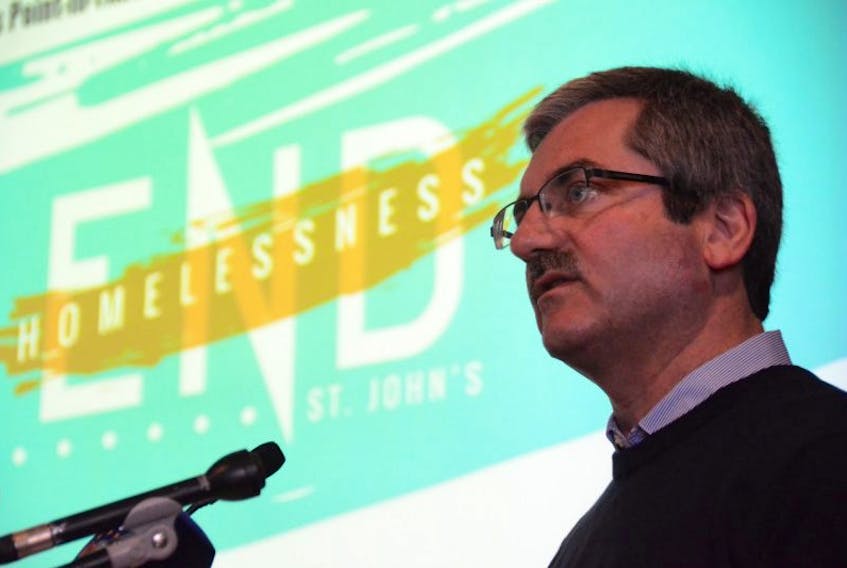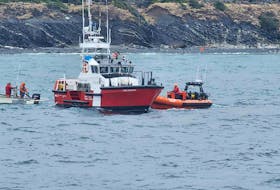That’s the night End Homelessness St. John’s held its first point-in time (PiT) count, something it plans to make a biennial event in order to get a better understanding of the homeless population in the area.
The results of the count came out in a report Tuesday, giving a glimpse of what homelessness looks like in the capital city. That night, 81 people stayed in emergency shelters; three stayed in unsheltered locations, such as a park or car; five stayed in transitional housing; 22 stayed at someone else’s house; and 55 stayed in institutional settings such as correctional facilities or addictions treatment centres.
The count found that 38 of those counted were young people. Seventeen were at emergency shelters; at least one stayed in an unsheltered location; 11 stayed at someone’s place; and nine were in institutional settings.
Data was taken from shelters, transitional housing facilities, hospitals and prisons, with more data collected by volunteers at many other sites.
End Homelessness St. John’s — a network of people from all sectors whose goal is in the group’s name — acknowledged that the number in the report is very likely higher than that. Shawn Skinner, the group’s chair, said there are certain limitations to the PiT count.
“We do not enter empty buildings. We don’t go into areas that may have liability issues or are deemed to be unsafe,” he said.
“So we’ve captured 166 people from this. We know some of them were institutionalized — that could be in jail, it could be hospitals, it could be transitional shelters — but there’s a whole other group that we don’t think we’re able to capture out there who are in other settings. Other setting could be parks, we saw some evidence of people in cemeteries, people in abandoned buildings and fields, and that kind of stuff. So these people are out there in our community, and we’re just trying to establish some baseline data so that we have some numbers to work with.”
Demographics
Along with getting a head count of the homeless population, the PiT count gathered information such as people’s age, race, sexuality and gender, and factors such as former involvement with corrections or child protection services.
Of the people counted that night, 84 participated in a survey. The results found that people from certain demographics were overrepresented, including indigenous people (19.2 per cent), people who identify as part of the LGBTQ2S community (21.7 per cent) and people who have been involved with child protection services (47 per cent).
The report also shows that a significant number of respondents — 38.3 per cent — experienced chronic homelessness, meaning they’d been homeless for at least half of the previous year. Another 7.4 per cent said they had been homeless at least three times in the previous year.
Next steps
The “sobering” results prompted much discussion about the next steps toward ending homelessness.
Skinner said some progress has already been made, and End Homelessness St. John’s can’t take all the credit; a network of organizations has been working toward the same goal. End Homelessness St. John’s is run by two paid staffers and many volunteers, and helps direct people in need to those support systems.
What’s needed now is programming money, he said.
“The various levels of government need to understand and need to trust and need to support the direction that we think we need to go in, and they need to make those services available. You can’t say, ‘We’ve got a system in place. Make the client fit the system.’ We’re saying, ‘These clients are telling us what we need; we need to build it to them to meet their needs,’” he said.
He said the funding needed for the services they’re seeking is not significant, and the cost of leaving things alone is “astronomically higher.”
“Not only does it save money, but it’s a better outcome for the people that we’re trying to affect. This is not about saving money … we recognize in doing the work we do, in helping the people we’re trying to help, that there are ways to save money.”
Keeping count
In other cities across Canada, a PiT count is done every two years between January and April. Skinner said the next one here will take place in 2018, but that time of year just wouldn’t work in St. John’s. Even doing it in November posed challenges.
“I’m going to try to see about getting it done a little earlier in the year, because our climate in November is really not a good time to be out there looking for people living out in the parks and cemeteries and those kinds of places,” he said. “I’d like to see sometime between May and October. I think that would give us a better barometer of who’s out there living homeless on the streets, living in transitional shelters and so on.”
That said, Skinner was delighted with the turnout at the first PiT count. More than 100 eager volunteers showed up to help.
The full report, written by Krista Gladney, can be viewed online at http://www.nlhhn.org/PDF/Everyone-Counts-SJS.pdf.
Twitter: @TelyLouis
Previous story:
Point-in-time count provides glimpse of homelessness in St. John’s
On the night of Nov. 30, at least 166 people experienced homelessness in St. John’s.
That’s the night End Homelessness St. John’s held its first point-in time count, something it plans to do to make a biennial event in order to get a better understanding of the homeless population in the area.
The results of the count came out in a report Tuesday, giving a glimpse of what homelessness looks like in the capital city.
That night, 81 people stayed in emergency shelters; three stayed in unsheltered locations, such as a park or car; five stayed in transitional housing; 22 stayed at someone else’s house, and 55 stayed in institutional settings such as correctional facilities or addictions treatment centres.
The count found that 38 of those counted were young people. Seventeen were at emergency shelters; at least one stayed in an unsheltered location; 11 stayed at someone’s place and nine were in institutional settings.
Data was taken from shelters, transitional housing facilities, hospitals and prisons, with more data collected by volunteers at many other sites.
Krista Gladney, who wrote the report, acknowledged the number is very likely higher.
“There are some groups that are difficult to locate — those staying in unsheltered locations,” she said.
The report also looked at factors such as age, race, sexuality, mental health, addictions, recent interactions with public systems, and history with child protection services.
More to come.









